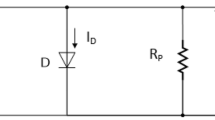Abstract
This paper presents a practical fuzzy controller two axes solar tracking-based realization on digital FPGA hardware. The fuzzy logic control is based according to Mamdani rules, alpha levels, max–min operations and defuzzification method. Operations and algorithms are reduced using look-up tables for the membership values which are stored as digital values and accessed to the control process. The feasibility and versatility of the proposed technique as well as its potential as a low-cost design for solar tracking control on digital field-programmable gate array (FPGA) are shown by simulated and experimental results in a photovoltaic system under different operation conditions. The proposed realization exhibits good performance related to the control and efficiency.




















Similar content being viewed by others
References
Youssef A, El-Telbany M, Zekry A (2017) The role of artificial intelligence in photo-voltaic systems design and control: a review. Renew Sustain Energy Rev 78:72–79
Antonio L, Steven H (2003) Handbook of photovoltaic science and engineering institute of energy conversion, University of Delaware, USA. Wiley Editorial, New York, pp 1020–1028
Sumathi V, Jayapragash R, Bakshi A, Akell PK (2017) Solar tracking methods to maximize PV system output: a review of the methods adopted in recent decade. Renew Sustain Energy Rev 74:130–138
Chavez UE, Yuri V (2013) Investigation of solar hybrid electric/thermal system with radiation concentrator and thermoelectric generator. Int J Photoenergy 2013:1–7
Njoku HO (2014) Solar photovoltaic potential in Nigeria. J Energy Eng 140:1–7
Zadey S, Dutt S (2013) Design of converter for low power photovoltaic conversion system. Int J Adv Res Electr Electron Instrum Eng 2(6):2733–2739
Aldali Y, Celik AN, Muneer T (2013) Modeling and experimental verification of solar radiation on a sloped surface, photovoltaic cell temperature, and photovoltaic efficiency. J Energy Eng 139:8–11
Abu-Rub H, Iqbal A, Ahmed Sk M (2012) Adaptive neuro-fuzzy inference system-based maximum power point tracking of solar PV modules for fast varying solar radiations. Int J Sustain Energy 31(6):383–398
Chekired F, Larbes C, Mellit A (2014) Comparative study between two intelligent MPPT-controllers implemented on FPGA: application for photovoltaic systems. Int J Sustain Energy 33(3):483–499
Gad HH, Haikal AY, Ali HA (2017) New design of the PV panel control system using FPGA-based MPSoC. Sol Energy 146:243–256
Wong J, Lim Y, Morris E (2015) Novel fuzzy controlled energy storage for low-voltage distribution networks with photovoltaic systems under highly cloudy conditions. J Energy Eng 141(1):1–15
Ansari MF, Chatterji S, Iqbal A (2010) A fuzzy logic control scheme for a solar photovoltaic system for a maximum power point tracker. Int J Sustain Energy 29(4):245–255
Altas IH, Sharaf AM (2008) A novel maximum power fuzzy logic controller for photovoltaic solar energy systems. Renew Energy 33(3):388–399
Barsoum N (2009) Implementation of a prototype for a traditional solar tracking system. In: Computer modeling and simulation, 2009. EMS’09. Third UK sim european symposium, IEEE, pp 23–30
Batayneh W, Owais A, Nairoukh M (2013) An intelligent fuzzy based tracking controller for a dual-axis solar PV system. Autom Constr 29:100–106
Chekired F, Larbes C, Rekioua D, Haddad F (2011) Implementation of a MPPT fuzzy controller for photovoltaic systems on FPGA circuit. Energy Procedia 6:541–549
Ahmad S, Shafie S, Ab Kadir MZA (2013) Power feasibility of a low power consumption solar tracker. Procedia Environ Sci 17:494–502
Prasanth Ram J, Rajasekar N, Miyatake M (2017) Design and overview of maximum power point tracking techniques in wind and solar photovoltaic systems: a review. Renew Sustain Energy Rev 73:1138–1159
Othman AM, El-arini MM, Ghitas A, Fathy A (2012) Real world maximum power point tracking simulation of PV system based on fuzzy logic control. NRIAG J Astron Geophys 1(2):186–194
Patyra MJ, Mlynek DM (2012) Fuzzy logic: implementation and applications. Wiley Editorial, New York, pp 237–242
Ozcelik S, Prakash H, Challoo R (2011) Two-axis solar tracker analysis and control for maximum power generation. Procedia Comput Sci 6:457–462
Tsai HL, Tu CS, Su YJ (2008) Development of generalized photovoltaic model using MATLAB/SIMULINK. In: Proceedings of the world congress on engineering and computer science WCECS, pp 1–6
Mendieta Garrido A (2013) Design of a PV plant for the Institute of Technology and Higher Education of Ecatepec, Master Dissertation
Hernández Zavala MA (2009) Arquitectura de Alto Rendimiento para Procesadores Difusos. Doctoral Dissertation, IPN, Mexico
Lughofer E, Sayed-Mouchaweh M (2015) Autonomous data stream clustering implementing split-and-merge concepts: towards a plug-and-play approach. Inf Sci 304:54–79
Lughofer E (2012) Hybrid active learning for reducing the annotation effort of operators in classification systems. Pattern Recognit 45:884–896
de Jesus Rubio J, Ochoa G, Meda JA, Rangel VI, Pacheco J (2015) Acquisition system and analytic fuzzy model of a manufactured wind turbine. IEEE Lat Am Trans 13(12):3879–3884
Rubio JJ, Bouchachia A (2016) MSAFIS: an evolving fuzzy inference system. Soft Comput. doi:10.1007/s00500-015-1946-4
Yurkovich S, Widjaja M (1996) Fuzzy controller synthesis for an inverted pendulum system. Control Eng Pract 4(4):455–469
Author information
Authors and Affiliations
Corresponding author
Ethics declarations
Conflict of interest
The authors state that they have no conflict of interest with the publication of this research paper. Likewise, they also would like to thank the reviewers for their valuable comments and suggestions to improve the present work.
Rights and permissions
About this article
Cite this article
de la Cruz-Alejo, J., Antonio-Méndez, R. & Salazar-Pereyra, M. Fuzzy logic control on FPGA for two axes solar tracking. Neural Comput & Applic 31, 2469–2483 (2019). https://doi.org/10.1007/s00521-017-3207-1
Received:
Accepted:
Published:
Issue Date:
DOI: https://doi.org/10.1007/s00521-017-3207-1




